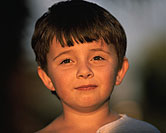
WEDNESDAY, Sept. 15 (HealthDay News) — Children with an autism spectrum disorder tend not to yawn “contagiously” — that is, yawn in response to seeing others yawn, a new study suggests.
Yawning is a type of “emotional contagion,” an unconscious response that reflects a recognition of how others are feeling. And unconsciously mimicking the behavior of parents and others is an important step in a child’s social and emotional development, said study lead author Molly Helt, a doctoral candidate at the University of Connecticut.
Autistic children’s lack of imitation puts them at a disadvantage when it comes to learning empathy and other social skills, Helt said. For example, prior research has shown that when people see others smile, they subtly smile as well. The movement of the facial muscles kicks a feedback mechanism into gear, lifting mood.
“‘Emotional contagion’ means I get to experience a little bit of the emotion you experience,” Helt said. “That gives rise to intuition, empathy and good social skills. The fact that autistic children are not yawning is a signal those basic social bonds that are forming in infants and children are not forming in children with autism.”
The study is published in the September/October issue of the journal Child Development.
In one experiment, researchers observed 120 typically developing children ages 1 to 6 years while they listened to a 12-minute story read aloud. The storyteller yawned four times during the reading.
Children began “contagious yawning,” or yawning within 90 seconds of seeing the storyteller yawn, at about age 4. About 35 percent of 4-year-olds and 40 percent of 5- and 6-year-olds yawned in response to seeing the storyteller yawn; none of the 1-year-olds, 5 percent of 2-year-olds and 10 percent of 3-year-olds yawned.
In a second experiment, the researchers observed 28 children ages 6 to 15 with an autism spectrum disorder and 63 children without autism who were matched for age or mental development. Again, the storyteller yawned four times.
Only about 11 percent of children with an autism spectrum disorder yawned after the storyteller yawned, compared to 43 percent of typically developing children.
Among children with autistic disorder, a more severe form of the syndrome, none yawned contagiously, while about 23 percent of kids with pervasive developmental disorder — a milder form of autism — yawned.
“Typical infants seem to be growing more emotionally attuned with others as they age, with the age of 4 being critical for that,” Helt said. “Kids with autism don’t seem to be becoming more and more emotionally attuned with others as they age.”
The study doesn’t prove that a lack of “contagious yawning” is a sure sign of a developmental problem.
Helt also noted that it’s possible that the autistic children weren’t paying attention to others around them, or they noticed the yawns and other facial expressions but didn’t know how to interpret them.
Geraldine Dawson is chief science officer for Autism Speaks, an advocacy group dedicated to funding research into the causes, prevention, treatment and a cure for autism. She said: “It is well known that children with autism are less likely to imitate other people. This study suggests that this difficulty in imitation extends to very basic behaviors, such as yawning.”
Intervention programs that target “imitation skills” can be very effective in helping children with autism in their social development, she added.
In a second study in the same issue of the journal, researchers from the Institute of Education in London found that thinking and perception skills of children with autism spectrum disorders can vary substantially among individual children and can improve over time.
The researchers assessed the abilities of 37 children with autism spectrum disorder and 31 typically developing children at ages 5 to 6 years and again three years later. The study found that not all children had the same level of weakness in each area, and after three years, many showed marked improvement.
Most children were better able to understand others’ thoughts and feelings, and had an improved ability to regulate and control their behavior.
More information
The U.S. National Institute of Neurological Disorders and Stroke has more on autism.

